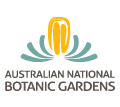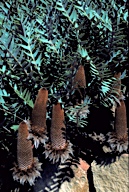
Australian National
Botanic Gardens
In Flower This Week
A weekly news-sheet prepared by a Gardens volunteer.
Numbers in brackets [ ] refer to garden bed 'Sections'. Plants in flower
are in bold type.
|
|
In Flower This WeekA weekly news-sheet prepared by a Gardens volunteer. |
10 October 2003
Wild about flowers this week at ANBG
If you’ve overdosed on colour at Floriade this spring you’ll be ready for a wander through the wild beauty of Australian native plants here at the Gardens. Don’t put your camera away though. If you “get up close and personal” with the exquisite flowers you will be rewarded with some great macro shots.
On the way to the rockery [Section 15] you will be stopped in your tracks by Hibbertia empetrifolia [Section 210] just before the waterfall, on the left of the path that leads to the cafe. The masses of yellow flowers on this sprawling plant sparkle like jewels in the sun, attracting busy bees. Walk ahead a few steps to the bridge and see this plant as you would in the wild, trailing over a rock next to the Xanthorrhoea glauca subsp. angustifolia [Section 60].
Veer to the left and walk up the road that skirts the rainforest. Don’t miss the pale lemon rock orchids, Dendrobium speciosum [Section 125] nestled in the rocks. Each spike holds dozens of perfect flowers. Time to find that macro setting on your camera! Just before you reach the brittle gum lawn you’ll be delighted with the splash of mauve flowers belonging to Indigofera australis [Section 114]. The mass display of flowers on this exquisite bush is as striking as the tiny flowers. Take a close look at them.
 |
|
Banksia blechnifolia
- click for larger image
|
As the road turns to the right you’ll be met by a carpet of yellow buttercups Ranunculus collinus [Section 78]. The perky little five-petalled flowers are sitting amongst the bright lime green foliage saying “Look at me”. The buttercups lead your eye to the pretty purple Prostanthera rotundifolia [Section 78]. You’ll see a breathtaking display of dozens of these round leaved mint bushes set on a slope with a beautiful back drop of green trees. This is definitely the week to see these plants in all their glory. You may even be able to smell the mint. Check out their next-door neighbours, the freshly fragrant Eriostemon myoporoides subsp. myoporoides [Section 78]. The bees love this plant and you will be fascinated with the pretty pink buds and tiny white flowers. Look into the garden and see these plants dwarfed by tall eucalypts, Grevillea robusta (Silky Oak) and Callitris species (native cypress pines) [Section 105].
Head down the path to the Rockery. You’ll see several striking strap-leaved plants with beautiful stalks of yellow flowers, Bulbine bulbosa [Section 15 a]. Yellow must be the colour of the week! You may be surprised to know that each of the star-like flowers on this plant lasts for just one day. When you pass by the colourful display of self-sown pink everlasting daisies, Rhodanthe chlorocephala subsp. rosea [Section 15 c], you’ll think you are on a Western Australian wildflower tour. On the right just before the bridge you’ll see the unusual bronze flower of another Western Australian plant, Banksia blechnifolia [Section 15 e] looking as if it is growing right out of the gravel. You won’t miss Isopogon cuneatus [Section 15 p] as it weeps over the boulders and brushes you with its showy purple flowers. What a stunning plant! As you head towards the sundial, look into the garden bed and see the white Waratah, Telopea speciosissima ‘Wirrimbirra White’ [Section 15 r]. The flowers are just beginning to open and have a hint of lemon in them at the moment.
Saving the best to last . . . take a rest on the seat at the far end of the rockery and notice Actinodium cunninghamii [Section 14]. You’ll be blown away by the red and salmon flowers that look like raspberry ice blocks. Wander back along the main path and soak up the sounds and scents of the bush.
Trish
|
Return to: |
Search |
Previous
|